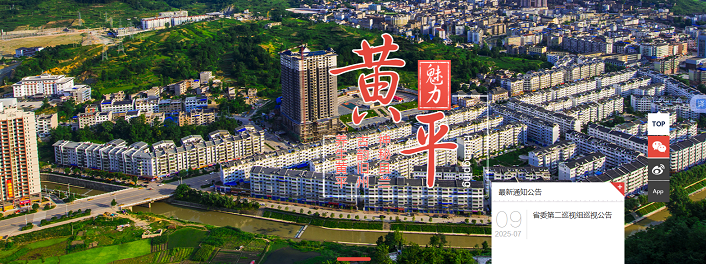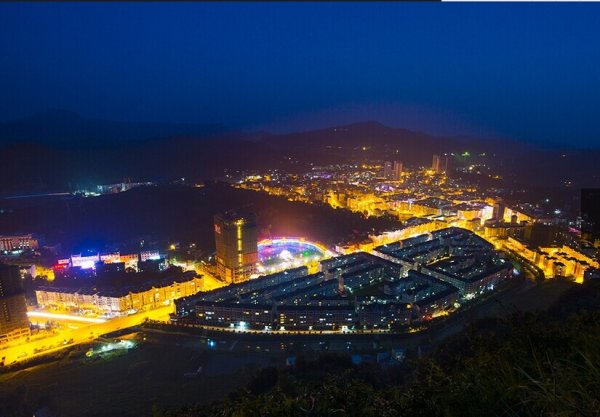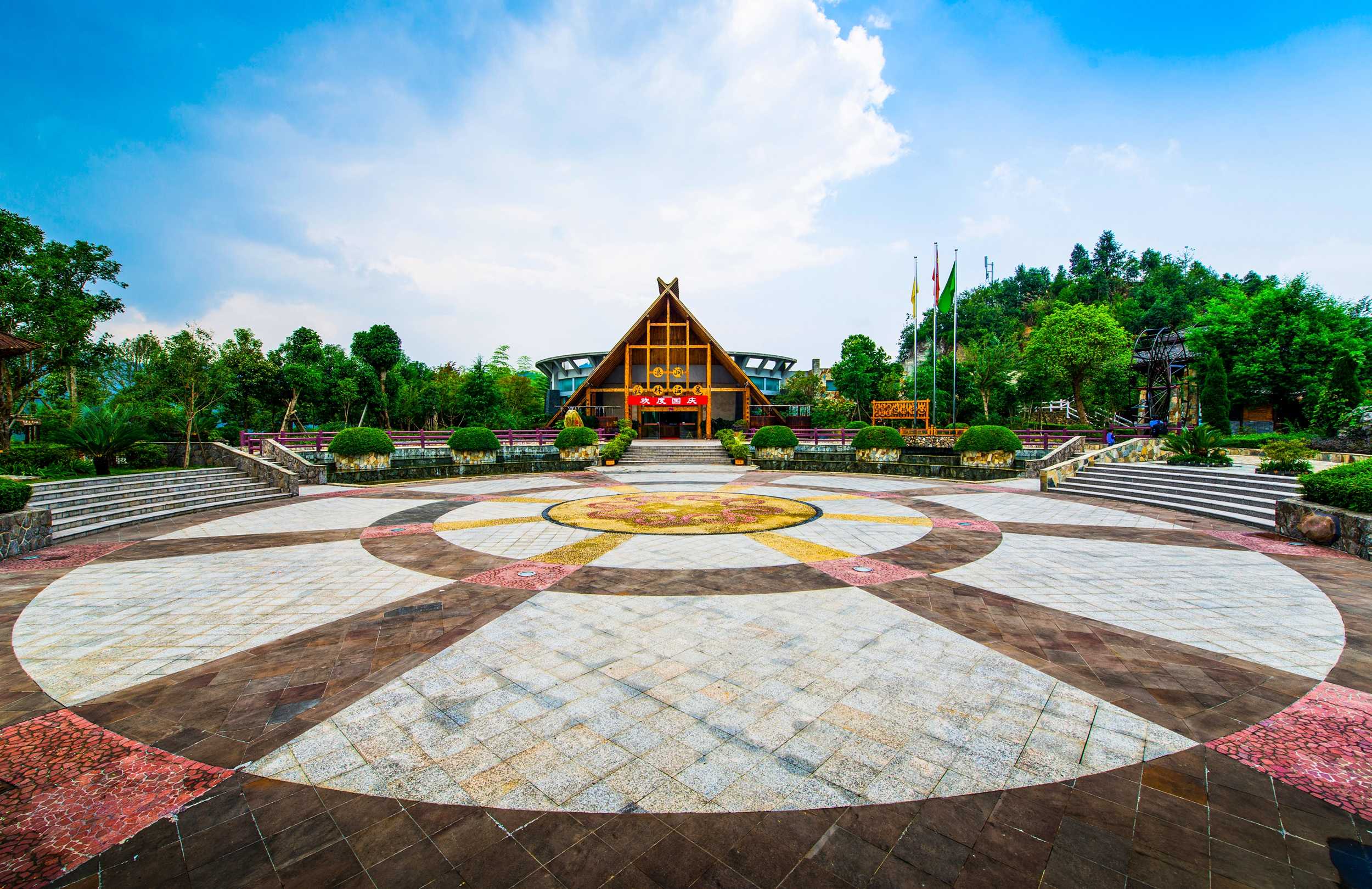- Profile Jurisdictions GOV DEPARTMENTS Cultures Travelling Educate
-
Huangping is located in the southeastern part of Guizhou Province, in the northwestern part of the Qiandongnan Miao and Dong Autonomous Prefecture, 50 kilometers from the prefectural capital of Kaili and 179 kilometers from the provincial capital of Guiyang. The county covers an area of 1,668 square kilometers, comprising 8 towns, 3 townships, 142 administrative villages, and 13 communities. As of 2024, the total population was 388,300. Huangping is a national key ecological function protection zone and is known as the “Hometown of Modern Folk Painting in China,” “Hometown of Clay Whistle Art in China,” “Hometown of High-Quality Seedless Watermelons in China,” and “Hometown of Longevity in Guizhou Province.”

Huangping has a long history and rich culture. During the Pre-Qin period (21st century BCE–221 BCE), it belonged to Liangzhou. During the Spring and Autumn and Warring States periods (770 BCE–221 BCE), it belonged to the Zangke Kingdom and the Qielan Kingdom. In the third year of the Republic of China (1914), Huangping Prefecture was abolished and renamed Huangping County. Huangping is renowned as the “Ancient Capital of Qielan Kingdom and the Most Scenic Region of Yunnan-Guizhou,” boasting the “Qielan Culture” dating back over 2,300 years, the “Red Culture” associated with the Red Army's four passes through Huangping during the Long March, the “War of Resistance Culture” linked to the old airport in Jiuzhou during World War II, and the “Celebrity Culture” connected to historical figures such as Wang Yangming, Lin Zexu, Guo Moruo, and other historical figures, as well as the “ethnic culture” of the Miao and Gelao peoples. The county has four national key cultural relics protection units and six provincial-level cultural relics protection units.
Huangping is blessed with beautiful mountains and rivers and abundant resources. Located in the subtropical monsoon climate zone, it has distinct seasons, a mild climate, and ample rainfall. The county has a variety of mineral resources, with 16 types of confirmed reserves, including coal, iron, vanadium, bauxite, lead, zinc, and barite. The county is home to nearly 3,000 species of wild plants, including over 1,000 medicinal species, with a forest coverage rate of 61.12%. There are nearly 100 rivers of various sizes within the county, with major rivers including the Wuyang River, Chong'an River (including the section within Qingjiang County), and Miaoli River, which belong to the Dongting Lake water system of the Yangtze River basin, covering an area of 1,236 square kilometers, accounting for 74% of the county's total water basin area; to the north is the Yuqing River, which belongs to the Wujiang water system of the Yangtze River basin, covering an area of 316 square kilometers, accounting for 19% of the total water basin area.

Huangping has convenient transportation and easy access. The Xiang-Qian Railway and the Zhu-Liu Double Track run through the townships of Gulong and Wengping. The county has established a transportation network system including the Yu'an Expressway, Anjiang Expressway, Tianhuang Expressway, and Kaili Huangping Airport. The Guiyang-Huangping Expressway (119 kilometers) is nearing completion and will soon be put into operation. Huangping will be integrated into the Guiyang 1-hour economic zone, the Chongqing 3-hour economic zone, and the Hangzhou 5-hour economic zone. The Kaili South Station of the Shanghai-Kunming High-Speed Railway is only a half-hour drive from Huangping County, and the Shanghai-Kunming Railway (Xiang-Qian Railway) crosses the county and has three stations. The S30 Yu'an-Anlong Expressway and the S62 Jiangkou-Duge Expressway have five toll stations within Huangping County: Huangping North, Huangping South, Chong'an, Kaili Huangping Airport, and Zhifang, connecting to the Shanghai-Kunming, Xiamen-Chengdu, and Hangzhou-Ruili expressways. Kaili Huangping Airport is 10 kilometers from the county seat and has established routes to Guiyang, Hangzhou, Xi'an, Kunming, Chongqing, Ningbo, Wuhan, Zhengzhou, Fuzhou, Nanning, and Shenzhen. Huangping has developed a modern three-dimensional transportation network that integrates railways, highways, and aviation, making travel north and south more convenient and efficient.
The name Huangping originates from the Miao language term “Wangqie.” “Wangqie” means “old state,” with “wang” meaning “emperor” and “qie” meaning “plain.” ‘Huangping’ thus means “imperial city.” Over time, “Huangping” evolved into its current form. In the 26th year of Emperor Kangxi's reign (1687), Xinglong Weiyuan was merged into Huangping Prefecture, with the prefectural seat relocated to the former Xinglong Weiyuan site. The original prefectural seat, Qulan, was renamed Jiuzhou, while Xinglong was renamed Xinzhou. The names “Jiuzhou” and ‘Xinzhou’ thus originated, though the Miao people continued to refer to Jiuzhou as “Wangqie.” In the 3rd year of the Republic of China (1914), Huangping Prefecture was renamed Huangping County.

In the 38th year of King Nan of Zhou (277 BCE), King Zhao Xiang of Qin conquered the Chu Wu Qian region and established the Qianzhong Commandery, with Huangping under its jurisdiction. In the 6th year of Emperor Wu's reign during the Han Dynasty (135 BCE), Emperor Wu sent Tang Meng to open up the Yelang region. Twenty-four years later, he subdued Qulan and established the Zangke Commandery with its territory, with Huangping under Zangke, and the commandery seat at Huangping (Old Prefecture).
In the first year of Emperor Yang of Sui's Kaihuang reign (581), Zang Prefecture was established on the former territory of the Han Dynasty's Zangge Prefecture, with two counties under its jurisdiction: Zangge and Binhua. The present-day territory of Huangping County was divided between the two counties.
After Emperor Gaozu of Tang's Wude reign (618), the counties of Jian'an, Xinxing, and Binhua were successively established within the territory of Huangping. The Xinzhou region was part of Xinxing County. During the Kaiyuan period (713–741) of Emperor Xuanzong, Zangzhou was downgraded to a tributary prefecture, and all its counties were transferred to Chongzhou. The original county of Shaoming under Chongzhou corresponds to the present-day area of Jiuzhou.
In the second year of Emperor Huizong's Daguang reign (1108), Zhenzhou was established, with Leiyuan County as its seat. The seat of Le Yuan County was the old prefecture. In the same year, Bo Prefecture was established, overseeing Bo, Langchuan, and Daisu counties. Most of Daisu County's territory is now within Huangping County. After the Song Dynasty's southern migration, a prefectural seat was established in the Huangping region, with its seat at the present-day old prefecture. The prefectural seat administered the entire territories of Huangping and Weng'an counties. In the sixth year of Emperor Lizong's Bao You era (1258), the name Huangping first appeared in historical records. In November, a new city was built in Huangping and named Zhenyuan Prefecture. During the Jingding and Chengchun years of Emperor Lizong and Emperor Duzong, the Mongol army captured Sishui and Bozhou and established a military governor's office in Huangping (the old prefecture).
In the 28th year of Emperor Shizu's reign (1291), the Yuan Dynasty established Huangping Prefecture following the Song Dynasty system, which belonged to Bozhou and was under the jurisdiction of the Sichuan Provincial Administration.
In the seventh year of the Hongwu reign of the Ming Dynasty (1371), the Huangping Prefecture was renamed the Huangping Paifu Commandery, subordinate to Bo Prefecture; in the eleventh year, the Huangping Garrison Thousand-Household Bureau was established; in the fifteenth year, the Huangping Garrison Commandery was established, and shortly thereafter, the Commandery was renamed the Thousand-Household Bureau; In the fifth month of the 22nd year of the Hongwu era (1389), Fu Youde subdued the Miao people of Langdong and established a garrison at Langdong (Xinzhou Town), renaming Langdong to Xinglong and placing it under the jurisdiction of the Guizhou Military Command.
In the 23rd year of the Wanli reign (1595), the five prefectures of Huangping, Caotang, Bainiu, Yuqing, and Chong'an under the jurisdiction of Bozhou were transferred to the jurisdiction of the Huangping Magistrate; in the 28th year, Bozhou was pacified, the Huangping Paifu was abolished, and Huangping Prefecture was established; in the 29th year, Bozhou was divided into Zunyi and Pingyue (Fujian) Prefectures, with Pingyue transferred to the jurisdiction of Guizhou and Huangping Prefecture under the jurisdiction of Pingyue.
In the 10th year of the Kangxi reign (1671) of the Qing Dynasty, the Huangping Thousand-Household Unit was merged into Huangping Prefecture; in the 26th year (1687), the Xinglong Garrison was abolished and merged into Huangping Prefecture, with the prefectural seat relocated to the garrison site. Xinglong was renamed Xinzhou, and the original prefectural seat was renamed Jiuzhou. In the 3rd year of the Jiaqing reign (1798), Huangping Prefecture was transferred to the jurisdiction of Zhenyuan Prefecture.
In the early years of the Republic of China (1912), Huangping Prefecture was administratively divided into three levels: districts, towns, and villages. The entire county was divided into 8 districts, 98 towns, and 1,410 natural villages. In the 3rd year of the Republic of China (1914), Huangping Prefecture was renamed Huangping County, and Zhenyuan Prefecture was renamed Zhenyuan Special Region.
In the 16th year of the Republic of China (1927), the county government office was renamed the county government, and the entire county was divided into six districts: Xinzhou, Chong'an, Jiuzhou, Gulong, Pingxi, and Taiping. Each district was further divided into three levels: baos, jias, and pai. In the 21st year of the Republic of China (1932), the entire county was reorganized into eight districts and 23 townships (zhen). Each township (zhen) was further divided into baos and jias. In 1938 (the 27th year of the Republic of China), townships were renamed “joint villages,” and the county was divided into six districts and 35 joint villages, with 199 villages and 2,017 neighborhoods under the joint villages. In 1940 (the 29th year of the Republic of China), the joint village system was abolished, and the county was reorganized into four guidance districts, three towns, and 20 townships, with 215 villages and 2,269 neighborhoods under the townships. In 1941, except for the areas directly administered by the county government, the county was divided into two districts, Jiu Zhou and Gu Long, with 20 townships. In 1947, the county was divided into two districts with 21 townships (towns), 173 villages, and 1,666 neighborhoods. In 1949, the number of villages was reduced to 170.
On November 14, 1949, the Huangping County People's Government was established, subordinate to the Zhenyuan Special Region. In July 1956, the Zhenyuan Special Region was abolished, and the Qiandongnan Miao and Dong Autonomous Prefecture was established, with Huangping under its jurisdiction. In January 1959, Shibing County was merged into Huangping County.
In 1950, the county was divided into four districts (Siping, Gulong, Chong'an, and Jiuzhou) and 21 townships. At the same time, the biao-jia system was abolished, and 164 villages and 1,457 agricultural cooperative groups were established.
In 1953, the county was divided into five districts and 71 townships. In 1956, this was adjusted to 43 townships.
In 1958, the districts were reorganized into people's communes, with management zones established under each commune. Villages were renamed production brigades, and agricultural cooperative groups were renamed production teams.
In 1961, the people's communes were abolished, and the district offices were restored. The management zones were reorganized into people's communes. In May 1962, Huangping and Shibing counties were separated, and the county was restored to 5 districts, 23 communes, 304 brigades, and 2,109 production teams.
In 1963, the original 23 communes were reorganized into 45 communes and 1 town, overseeing 266 brigades and 2,091 production teams.
By 1973, the county was divided into 5 districts, 25 communes, and 3 towns.
In April 1984, communes were renamed townships, with township people's governments established; production brigades were renamed villages, with village committees established, and production teams were renamed village groups. The county was divided into 5 districts, 22 townships, 3 towns (including 1 district-level town), 250 villages, and 2,120 village groups.
In 1992, the five districts of Xinzhou, Jiuzhou, Pingxi, Chong'an, and Gulong were abolished, and five towns (Xinzhou, Jiuzhou, Chong'an, Gulong, and Pingxi) and nine townships (Chongren (renamed Yedonghe in 2005), Huangpiao, Shangtang, Yiwanshui, Wengping, Chongxing, Miaolong, Langdong, and Zhifang) were established.
In 2013, Huangpiao Township was merged into Xinzhou Town, Chongxing Township into Zhong'an Town, and Miaolong Township into Gulong Town. Yedonghe, Shangtang, and Langdong were downgraded from townships to towns, leaving the county with 8 towns and 3 townships. At the same time, the number of administrative villages was reduced from 243 to 142.
contact details
Tel:00-86-0855-3932184
Address:4th Floor, Administrative Center, Xinzhou Town, Huangping County
Working hours:National statutory working days (8:30 AM–12:00 PM; 2:00 PM–5:30 PM)
